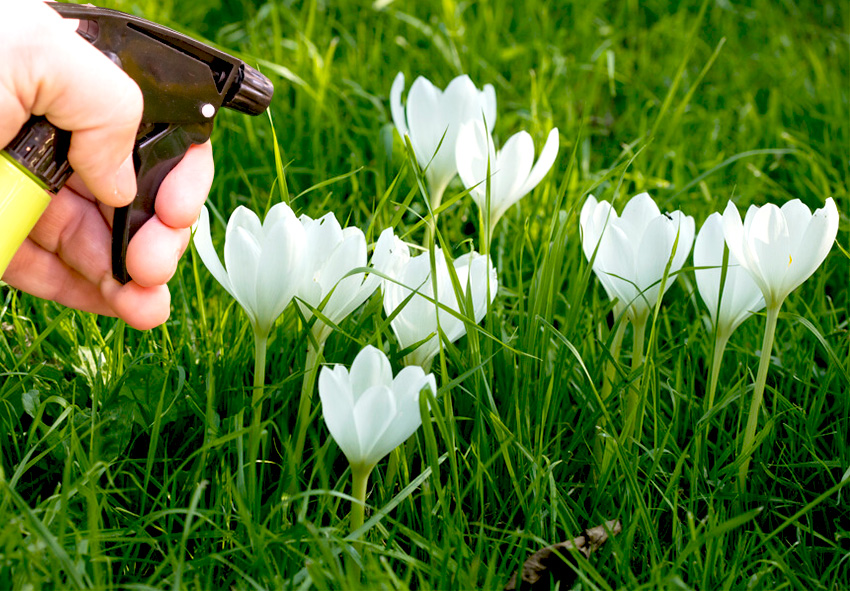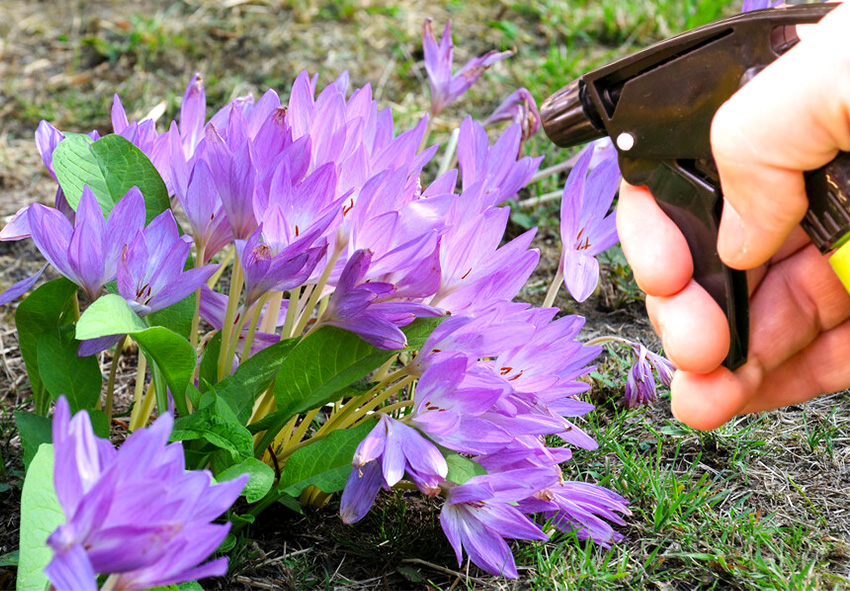Colchicums, also known as autumn crocuses, are prized for their vibrant blooms that bring color to the garden just as most other plants begin to fade. However, these delicate perennials can fall victim to various pests if not properly protected. In this article, we’ll explore common colchicum pests, prevention methods, and effective treatments to keep your garden thriving. Our gardening blog is a perfect place to find all the information you need!
Common Pests That Affect Colchicums

Colchicums, especially when newly planted, are vulnerable to a range of pests that target both their bulbs and foliage. From small insects to curious mammals, these threats can hinder healthy growth and reduce blooming. Early detection and proper control can help safeguard your plants:
- Slugs and Snails: Slugs and snails are some of the most common culprits that attack colchicums. They typically feed on tender foliage and petals, leaving behind ragged holes and a shiny slime trail. These pests are particularly active in moist autumn conditions, making colchicums an easy target.
- Rodents and Squirrels: Mice, voles, and squirrels are known to dig up and eat colchicum bulbs, especially during dry or cooler months. They may also disturb the soil around your plants while searching for food. Using mesh or placing chicken wire over planted areas can help deter them.
- Aphids: Aphids feed on the sap of colchicum leaves and can cause curling, yellowing, and stunted growth. They may also spread diseases between plants. Early infestations can be controlled with water sprays or insecticidal soap.
- Bulb Mites: These microscopic pests can cause serious damage to colchicum bulbs, leading to soft spots, rot, and reduced flowering. Bulb mites thrive in damp, poorly drained soil and are often introduced through infected bulbs. Always inspect bulbs before planting and avoid replanting in infested areas.
Signs of Pest Damage in Colchicums
Recognizing the early signs of pest damage is key to intervening before it’s too late. Colchicums tend to suffer in silence, but their appearance can reveal the problem if you know what to look for.
Chewed Leaves and Flowers
Chewed or shredded petals and leaves often point to slug or snail activity. Look for holes in the foliage or uneven edges along blooms.
Wilting or Rotting Bulbs
If bulbs begin to rot or collapse, bulb mites or poor drainage could be to blame. Healthy bulbs should feel firm — if they’re mushy or discolored, pest damage is likely.
Sticky Residue or Mold
Sticky residue on leaves is a sign of aphid feeding, often followed by sooty mold. This dark, powdery fungus grows on aphid secretions and blocks sunlight from reaching plant tissue.
Preventive Measures for Pest Control
The best way to deal with pests is to prevent them from establishing in the first place. Creating a clean, well-maintained environment helps your colchicums thrive without the constant threat of infestation.
- Proper Site Selection and Drainage: Choose a sunny or partially shaded location with well-drained soil. Avoid soggy areas, as standing water encourages rot and attracts bulb mites. Raised beds or sandy loam can help improve drainage naturally.
- Clean Garden Practices: Remove dead foliage and spent blooms to eliminate hiding spots for pests. Keep surrounding areas weed-free and clear any debris before planting. In autumn, tidy up nearby mulch and leaf litter where slugs may hide.
- Physical Barriers and Traps: Protect bulbs with wire mesh or gravel mulch to deter rodents. Beer traps or copper tape can be used to manage slugs effectively. Slug pellets should be used cautiously, as they can harm pets and wildlife.
Natural and Organic Pest Control Methods

If pests appear despite your best efforts, natural remedies can be both effective and environmentally safe. These options are ideal for gardeners who prefer chemical-free solutions.
Neem Oil and Insecticidal Soaps
Neem oil works well on aphids and mites by disrupting their feeding and reproduction. Insecticidal soaps are another gentle alternative that breaks down pests’ protective coatings. Apply early in the morning or evening to avoid harming beneficial insects.
Beneficial Insects
Encourage natural predators like ladybugs, lacewings, and hoverflies to visit your garden. These insects feed on aphids and other soft-bodied pests. Planting flowers like dill, alyssum, and yarrow nearby can attract them.
Homemade Remedies
Sprays made from garlic, chili, or vinegar can deter pests from feeding on your plants. Always test on a small area before full application to avoid foliage damage. Reapply after rain for continued protection.
Chemical Treatments and When to Use Them
For severe infestations, chemical options may be necessary as a last resort. Choose products carefully and follow all usage instructions.
Choosing the Right Product
Select pesticides and fungicides specifically labeled for bulbs or ornamental flowering plants. Avoid general-use products that may harm sensitive varieties like colchicums.
Application Timing and Safety Tips
Applying chemical treatments correctly is just as important as choosing the right product. To minimize harm to your plants, pollinators, and the environment, follow these essential tips when treating colchicums for pests:
- Apply Early or Late in the Day: Spray during early morning or late evening to avoid intense sun, which can cause chemicals to evaporate quickly or scorch leaves.
- Avoid Windy Conditions: Choose a calm day to prevent drift, which can carry chemicals onto nearby plants, beneficial insects, or water sources.
- Wear Protective Gear: Always use gloves, long sleeves, and eye protection when handling pesticides or fungicides to minimize skin and eye contact.
- Keep Pets and Children Away: Restrict access to treated areas until the product has dried completely to ensure safety for animals and small children.
- Follow Label Instructions Exactly: Use only the recommended amount and reapplication frequency stated on the label — overuse can damage plants and the ecosystem.
Long-Term Strategies for Healthy Colchicums

Protecting your colchicums isn’t just about treating pests when they appear — it’s about building resilience in your garden over time.
Crop Rotation and Soil Health
Avoid planting colchicums in the same location year after year. Rotate with unrelated plants to reduce soil-borne pests. Adding compost improves soil health and microbial balance, making plants naturally stronger.
Seasonal Maintenance Tips
Inspect bulbs annually before replanting and discard any with signs of rot or damage. Mulch in early fall to protect against rodents and frost, and clear the mulch in spring to expose emerging growth.
Conclusion
Keeping your colchicums free from pests is essential to enjoy their full beauty each autumn. By identifying common pests, implementing prevention strategies, and using organic or chemical treatments wisely, you can protect your garden investment. Ready to plant or replant? Explore our store’s wide selection of healthy colchicum bulbs and organic pest control solutions for a beautiful, worry-free bloom season.
Frequently Asked Questions (FAQs) about Planting Colchicums
1. What are the most common pests that affect colchicums?
The most common pests include slugs, snails, aphids, and occasionally bulb mites. These pests can damage the foliage and bulbs, affecting the plant’s ability to flower and thrive. Early detection and integrated pest control methods can help minimize damage and keep your colchicums healthy throughout the season.
2. Are chemical pesticides safe to use on colchicums?
Yes, but they must be used with caution. Choose pesticides labeled safe for ornamental bulbs and follow all instructions precisely. Avoid overuse and apply during cooler parts of the day to prevent harm to pollinators and nearby plants. Whenever possible, opt for eco-friendly alternatives to minimize environmental impact.
3. How can I prevent pest problems in colchicums naturally?
Natural prevention includes keeping the planting area clean, spacing bulbs for air circulation, and using organic mulches. Companion planting and introducing beneficial insects like ladybugs can also reduce pest populations. These methods support long-term plant health without relying on chemicals.
4. Can colchicum bulbs be ordered from your online store?
Our online store Dutch-bulbs.com offers a wide selection of colchicum bulbs, making it easy for you to add these plants to your garden. We source our bulbs from reputable growers to ensure you receive high-quality specimens. Simply browse our online catalog, select your preferred varieties, and follow the easy ordering process.
5. When is the best time to inspect colchicums for pests?
Begin monitoring in early spring and continue through the growing season. Pests often become active during periods of warmth and moisture. Regularly check leaves, stems, and soil around the bulbs to catch infestations early and act before serious damage occurs.
Published: 24.06.2025
